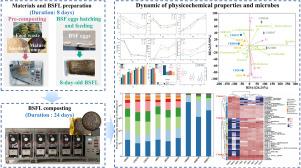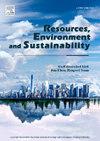An efficient strategy to promote food waste composting by adding black soldier fly (Hermetia illucens) larvae during the compost maturation phase
IF 12.4
Q1 ENVIRONMENTAL SCIENCES
引用次数: 0
Abstract
The increasing generation of food waste (FW) poses a significant challenge to global food security and environmental sustainability. Composting is an effective way to recycle FW, while the disease risk of immature compost and the long durations needed for mature compost restrict the application. To address these concerns, black soldier fly larvae (BSFL) were applied in the maturation phase to improve composting efficiency. The results demonstrated that adding BSFL expedited the composting process, achieving the fully mature compost within 25 days. This was evidenced by the elevated nitrate content (1057.52–1475.58 mg/kg) and germination index (GI) (100.2%–107.03%), along with a decreased nitrification index (0.19–0.24) of the BSFL-treated composts. Microbial analysis revealed a discernible elevation in the relative abundance of Ureibacillus, Lysinibacillus, Paneibacills, and Brevibacillus within the compost attributed to the addition of BSFL. Furthermore, BSFL introduction might enhance metabolic functions such as glycolysis, inosine monophosphate biosynthesis, gluconeogenesis, and lysine biosynthesis. As composting progressed, the relative abundance of certain bacteria, like Moheibacter and Actinomadura (initially more prevalent in the compost pile), gradually increased in the gut of BSFL. These findings suggest the existence of complex microbial interactions between the BSFL gut and compost, reshaping the mutual bacterial community and exerting some influence on the compost’s metabolic functions. Furthermore, redundancy analysis indicated significant associations between compost’s physiochemical properties (i.e., electrical conductivity, moisture content, GI, pH, and NH-N) and microbial community across all experimental groups. The discoveries provide valuable insights for the further evolution and functional research of BSFL gut microbiota.

在堆肥成熟阶段添加黑兵蝇(Hermetia illucens)幼虫以促进厨余堆肥的有效策略
日益增多的食物垃圾(FW)对全球粮食安全和环境可持续性构成了重大挑战。堆肥是回收利用厨余垃圾的有效方法,但不成熟堆肥的疾病风险和成熟堆肥所需的长时间限制了堆肥的应用。为了解决这些问题,我们在成熟阶段添加了黑实蝇幼虫(BSFL),以提高堆肥效率。结果表明,添加 BSFL 加快了堆肥过程,使堆肥在 25 天内完全成熟。经 BSFL 处理的堆肥中硝酸盐含量(1057.52-1475.58 毫克/千克)和发芽指数(GI)(100.2%-107.03%)升高,硝化指数(0.19-0.24)降低,都证明了这一点。微生物分析表明,添加 BSFL 后,堆肥中 Ureibacillus、Lysinibacillus、Paneibacills 和 Brevibacillus 的相对丰度明显提高。此外,BSFL 的引入可能会增强新陈代谢功能,如糖酵解、单磷酸肌苷的生物合成、葡萄糖生成和赖氨酸的生物合成。随着堆肥过程的进行,BSFL 肠道中某些细菌(如 Moheibacter 和 Actinomadura,最初在堆肥中较为普遍)的相对丰度逐渐增加。这些发现表明,BSFL 肠道与堆肥之间存在复杂的微生物相互作用,重塑了相互间的细菌群落,并对堆肥的代谢功能产生了一定影响。此外,冗余分析表明,在所有实验组中,堆肥的理化性质(即导电率、含水量、GI、pH 值和 NH4+-N)与微生物群落之间存在显著关联。这些发现为进一步研究 BSFL 肠道微生物群的进化和功能提供了有价值的见解。
本文章由计算机程序翻译,如有差异,请以英文原文为准。
求助全文
约1分钟内获得全文
求助全文
来源期刊

Resources Environment and Sustainability
Environmental Science-Environmental Science (miscellaneous)
CiteScore
15.10
自引率
0.00%
发文量
41
审稿时长
33 days
 求助内容:
求助内容: 应助结果提醒方式:
应助结果提醒方式:


